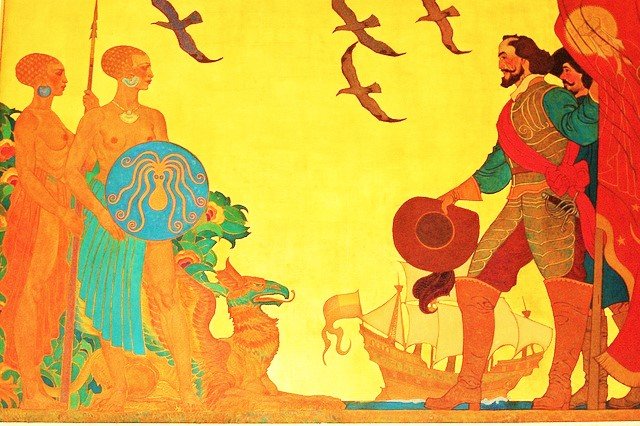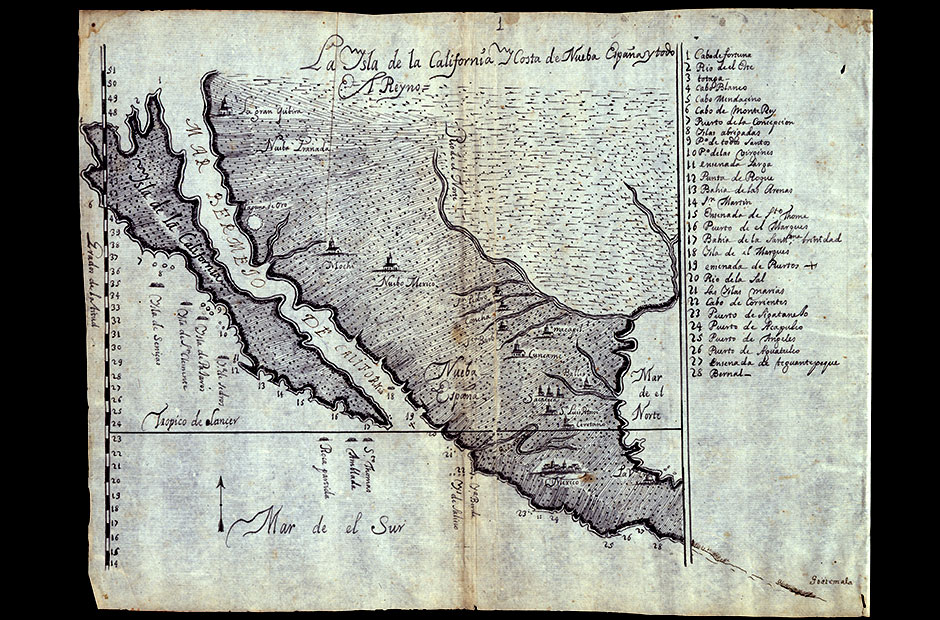Calafia is a pagan who is convinced to raise an army of women warriors and sail away from California with a large flock of trained Griffins (a legendary creature with the body, tail, and back legs of a lion; the head and wings of an eagle) so that she can join a Muslim battle against Christians who are defending Constantinople. In the siege, the griffins harm enemy and friendly forces, so they are withdrawn. Calafia and her ally Radiaro fight in single combate single combat against the Christian leaders, a king and his son the knight Esplandián. Calafia is bested and taken prisoner, and she converts to Christianity. She marries a cousin of Esplandián and returns with her army to California for further adventures.
(image Queen Califia by CalifiabyTheArthurWrigh)
The name of Calafia was likely formed from the Arabic word KHALIFA (religious state leader) which is known as CALIPH in English and CALIFA in Spanish. Similarly, the name of Calafia's monarchy, California, likely originated from the same root, fabricated by the author to remind the 16th-century Spanish reader of the Reconquista, a centuries-long fight between Christians and Muslims which had recently concluded in Spain. The character of Calafia is used by Rodríguez de Montalvo to portray the superiority of chivalry chivalry in which the attractive virgin queen is conquered, converted to Christian beliefs and married off. Califia, has been depicted as the Spirit of California, and has been the subject of modern-day sculpture, paintings, stories and films; she often figures in the myth of California's origin, symbolizing an untamed and bountiful land prior to Europeans taking the land by force.
(Griffins)
 In the book The Adventures of Esplandián the story of Calafia is introduced as a curiosity. Calafia is introduced as a regal black woman, courageous, strong of
limb and large of person, full in the bloom of womanhood, the most
beautiful of a long line of queens who ruled over the mythical realm of
California. She commanded a fleet of ships with which she demanded tribute from
surrounding lands, and she kept an aerial defense force of griffins,
fabulous animals which were native to California, trained to kill any
man they found.
In the book The Adventures of Esplandián the story of Calafia is introduced as a curiosity. Calafia is introduced as a regal black woman, courageous, strong of
limb and large of person, full in the bloom of womanhood, the most
beautiful of a long line of queens who ruled over the mythical realm of
California. She commanded a fleet of ships with which she demanded tribute from
surrounding lands, and she kept an aerial defense force of griffins,
fabulous animals which were native to California, trained to kill any
man they found.Calafia meets Radiaro, a Moslem warrior who convinces her that she should join him in retaking Constantinople from the Christian armies holding it. Calafia, in turn, convinces her people to take their ships, weapons, armor, riding beasts, and 500 griffins, and sail with her to Constantinople to fight the Christians, though she has no concept of what it means to be Moslem or Christian.
Landing near Constantinople, Calafia meets with other Moslem warrior leaders who were unable to remove King Amadis and his Christian allies from the city, and she tells them all to hold back and watch her manner of combat—she says they will be amazed. The next morning, she and her women warriors mount their "fierce beasts" wearing gold armor "adorned with the most precious stones", advancing to invest the city.
Terrific battles raged along the city's walls but the attackers were repulsed. Calafia led a picked group of women warriors to attack a city gate, one held by Norandel, the half-brother of King Amadis. Norandel charged out of the gate against Calafia; upon meeting their two lances were broken but the warriors remained standing. They struck at each other with sword and knife, and a general melee ensued, Calafia throwing knights from their horses and taking great blows on her shield. Two more knights charge forward from the city, nobles named Talanque (a nephew of King Amadis) and Maneli, a prince of Ireland. The next day, Calafia duels with King Amadis trade blows until he disarms her and knocks her helmet off. Both Calafia and Radario surrender to the Christians.
While being held prisoner, Calafia acknowledges the astonishing beauty of Leonorina, daughter of the Constantinople emperor and the intended bride of Esplandián, and resolves not to interfere with their union. She accepts Christianity as the one true faith, saying, "I have seen the ordered order of your religion, and the great disorder of all others, I have seen that it is clear that the law which you follow must be the truth, while that which we follow is lying and falsehood." She marries Talanque, a large and handsome knight who fought with her outside the city gate; similarly, her sister Liota marries Maneli, Talanque's companion in arms. The women return to California with their husbands to establish a new dynasty complete with both sexes, as a Christian nation.
(image: Espadian by: Getty)
The first voyage of Christopher Columbus. Christopher Columbus in the late 15th century sparked a new interest in the search for "Terrestrial Paradise", a legendary land of ease and riches, with beautiful women wearing gold and pearls. Spanish author Garci Rodriguez de Montalvo Garci Rodríguez de Montalvo drew upon reports from the New World to add interest to his fantasy world of chivalry and battle, of riches, victory and loss, of an upside-down depiction of traditional sex roles. Around the year 1500 in his novel The Adventures of Esplandián, he writes: "Know ye that at the right hand of the Indies there is an island called California, very close to that part of the Terrestrial Paradise, which was inhabited by black women without a single man among them, and they lived in the manner of Amazons Amazons. They were robust of body with strong passionate hearts and great virtue. The island itself is one of the wildest in the world on account of the bold and craggy rocks."





No comments:
Post a Comment